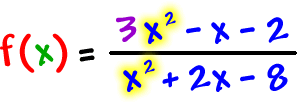Since we understand all this horizontal asymptote junk, we can even do these guys without the graph!
Check it out:

Since the horizontal asymptote is y = 3,
![]()
![]()
Draw the graph to double-check.
TRY IT:
For each of the following, without doing the graph, find the end-tail behavior as ![]() and as
and as ![]() . Double check your answers by graphing.
. Double check your answers by graphing.



